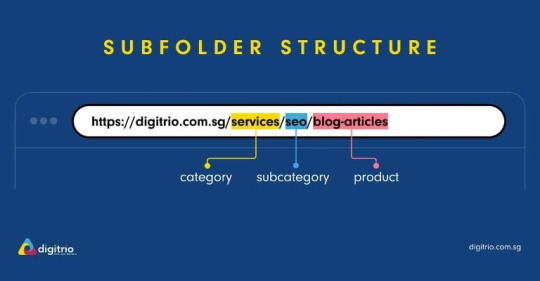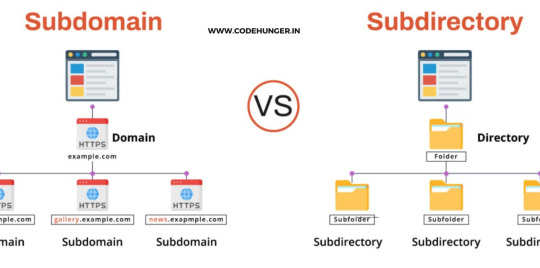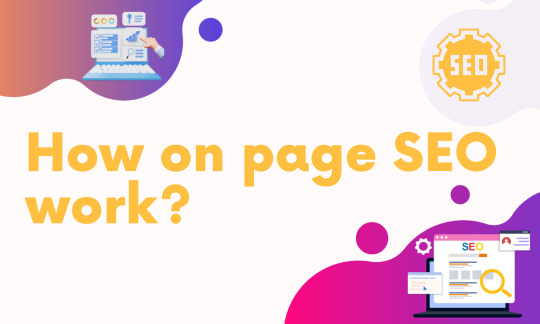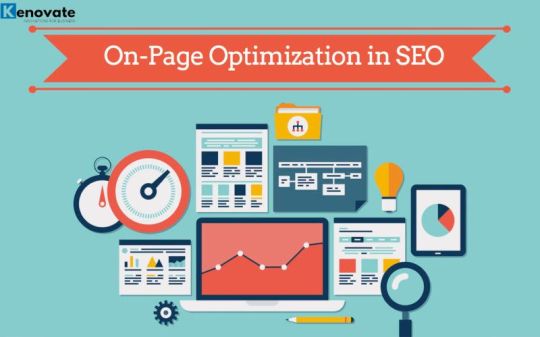#URL Structure
Explore tagged Tumblr posts
Text
Url Structure & Its Importance : The Complete Guide
URLs are one of the most basic yet crucial elements of SEO. Even today, many SEO experts tend to overlook it. Good URL structure of a website can help improvise SEO by providing an excellent navigational experience. It can also be tracked in Google Analytics or Adobe Analytics for data monitoring purposes.
In this article, we will discuss the necessary information of URLs like, what is URL? How a URL looks like? What are the URL structure and the importance of it?
What is the URL?
URL is an abbreviation for “Uniform Resource Locator” and is used to identify the address of particular documents or other resources on the internet. URLs consist of multiple parts that include “a protocol and a domain name.” It tells a browser about how and from where to retrieve a resource.
What is the URL structure?
URL structure is the anatomy of how a particular URL looks like. Usually, it either starts with “http or https.”
S stands for the secured version of websites in “https.” It is recommended to use “https” for the various reasons that you can read here.
Then follows, www and the name of your domain, like https://www.infidigit.com and then comes the directory or the path where your content is stored that is, https://www.infidigit.com/e-commerce-seo/.
Now,
What is the importance of URL structure in SEO?
If you observe the SERP results carefully, you won’t see a URL that has improper structure. Either you see a search result with breadcrumbs or a proper URL structure.
Every search result has three main components that a user will see. They are:
Title
URL
Description
We believe that the first impression always counts and search engines like Google takes this very seriously. Based on these components, a user is likely to click on a search result.
0 notes
Text
How to Create a Perfect URL Structure in SEO for Your Website
Uniform Resource Locators, or URLs, are the web addresses that people and search engines use to get to a certain page.
They come in different types, such as static URLs (which don’t change over time) and dynamic URLs (which are made when certain content is called up, often with parameters).
URL optimization can have a big effect on how search engines rank your content and how people use your site, whether it’s for a blog post, a sales page, or a landing page.
The Role of URL Structure in SEO
There is no way to overestimate how important a good SEO URL structure is. As a foundational part of any good SEO plan, this has a significant effect on your site’s search rankings and how people feel about using it.
There is no way to overestimate how important a good SEO URL structure is. As a foundational part of any good SEO plan, this has a significant effect on your site’s search rankings and how people feel about using it.
Let’s break down a well-structured URL into its main parts to better understand why it is so important for SEO.
Search Engine Crawling and Indexing
Search engines crawl your website using several signals to ascertain the relevancy of your content to particular searches. They come upon your URL first, among other things.
Clear, short URLs enable Google and other search engines to identify a website’s content precisely, therefore facilitating indexing and ranking.
Higher search results follow from better search engine crawling and classification of your material, which is made possible by using descriptive URLs, including pertinent keywords.
Impact on User Experience and Click-Through Rate (CTR)
Not only does a well-structured URL help search engines, but it also directly influences user experience. Before users ever click on a page, a basic, understandable URL lets them rapidly grasp its purpose. This, in turn, raises click-through rates (CTR), a primary ranking consideration for SEO.
From what I have seen, websites with well-defined, obvious URLs often have more traffic. This increased involvement indicates to search engines that your content is relevant and important, strengthening their impressions of your work and helping to drive ranks higher.
SEO URL Length: Keeping It Short and Sweet
Regarding URLs, length counts, but longer does not always equal better. A perfect SEO URL length is usually under 60 characters. Search engines like shorter URLs because they are more user-friendly and easier to show in search results.
Shorter URLs are more aesthetically pleasing and simpler to understand at a glance, so they often show better CTRs. Shorter URLs also make sharing across platforms — from printed documents to social media and email — easier.
Hierarchy and Site Structure
A well-structured URL reflects your website’s hierarchy, facilitating search engine understanding of the relationships between several pages. If your site’s hierarchy is apparent, users and search engines will find it more straightforward.
An e-commerce website might, for instance, employ this kind of organization: yourdomain.com/mens/shirts/clothing
This URL offers clear, rational navigation. Emphasizing shirts, it tells search engines and visitors that the page falls within the clothing category — more especially, under men. By making the site more straightforward to utilize, this well-defined hierarchy benefits not only SEO but also user experience.
On the flip side, a URL such as yourdomain.com/category-123 offers no hints regarding the material’s connection to the rest of the website. Confusing URL structures could make it difficult for search engines to evaluate how important or relevant a page is within the website’s architecture, thereby affecting the ranks.
Internal Linking and URL Consistency
Search engines crawl your site based mostly on internal linking, so URLs form the cornerstone of that approach. A neat, well-structured URL facilitates user and search engine followability when you build links inside your material pointing to other pages on your website.
The clean URL lets visitors trust the link and facilitates search engine understanding of the link’s relationship between the two pages.
Furthermore, consistency in your URL structure enhances internal linkage. Search engines will find it simpler to grasp the content and context of your site when all of your URLs follow the same format, therefore improving the overall experience for visitors and search engines.
Best Practices for URL Redirects
Eventually, particularly if you have rebuilt your website, you will probably have to redirect old URLs to new ones. Properly controlling this redirection is crucial for maintaining your SEO value.
A 301 redirect tells search engines the page has permanently relocated and passes the SEO value from the old URL to the new one. This guarantees that your site keeps its ranks following a URL change and helps prevent broken links. Without correct redirection, you risk losing important SEO traffic and people who come across broken links leaving your site, hence raising bounce rates.
What Makes a URL SEO-Friendly?
So, how do you create the ideal URL? Based on my years of expertise in SEO, here are 10 thorough guidelines to assist you in creating page URL links that drive more traffic, improve ranks, and offer a better user experience.
Use Main Keywords in the URL
One of the most basic elements of URL optimization is still including pertinent keywords in the URL. These keywords let search engines rapidly grasp the nature of the page.
For instance, the URL yourdomain.com/hiking-tips not only helps users but also increases your chances of ranking higher for the keyword hiking tips if your website is about hiking advice.
Google explicitly notes in its Search Engine Optimization Starter Guide that URLs that include relevant keywords can offer a modest SEO boost.
Keep Your URLs Short and Simple
The key element of SEO-friendly URLs is simplicity. From what I know, URLs that are too long typically show worse in search engine results. Because they are simpler to read, remember, and share, users also want shorter URLs.
For example, yourdomain.com/best-camping-gear is better than yourdomain.com/best-camping-gear-for-beginners-guide-in-2025
The shorter form packs the same search engine optimization without overpowering the reader and is more user-friendly.
Avoid Special Characters
Special characters, including &, %, and @, might perplex search engines and users. URLs using these characters are more difficult for search engines to crawl and index since they usually become illegible.
Many websites I have seen suffer from low results only because their URLs are filled with pointless characters. Instead, stay with letters, numbers, and hyphens.
Use Hyphens, Not Underscores
Google claims that to separate words, URLs should employ hyphens (-) instead of underscores (_). This is so because search engines regard stresses as word joiners but identify hyphens as word separators.
This little change will enable your results to rise for particular keyword combinations.
Minimize URL Folders
Another important advice is to reduce the number of directories or folders in your URL.
Overcomplicated systems like yourdomain.com/category/blog/2024/tips/travel might confuse search engines and complicate their ability to index your material effectively. Instead, choose a flatter arrangement akin to yourdomain.com/travel-advice
Users find it simpler, and search engines value this simplicity as well.
Be Descriptive, Not Generic
One common mistake I see is utilizing generic or imprecise URLs that lack sufficient information for search engines or people.
URLs like yourdomain.com/post1234 or yourdomain.com/page4568 give search engines nothing about the page, reducing your chances of ranking for pertinent search terms.
A more descriptive URL like yourdomain.com/budget-travel-guide is considerably more successful at generating visitors because it clearly conveys the topic.
Use Lowercase Letters for URL
URL capital letter usage can lead to technical problems like duplicate content concerns.
Split ranking signals could arise from Google treating yourdomain.com/About-Us differently from yourdomain.com/about-us
In my experience, keeping lowercase characters guarantees that search engines treat all of your URLs consistently, making it a perfect approach to avoid such problems.
No Session IDs or Tracking Parameters
For SEO, dynamic URLs using session IDs or tracking criteria — like yourdomain.com/product?sessionid=458 &ref=adcampaign — are not the best.
These URLs are more difficult for search engines to index and can cause copy problems. Instead, use yourdomain.com/product-name clear, stationary URLs.
If you must monitor campaigns outside of your primary URL structure, employ URL shortening tools or appropriate UTM tagging.
Implement Canonical Tags for Duplicates
In cases where you might have several URLs for the same page (e.g., yourdomain.com/product and yourdomain.com/product?ref=affiliate), use canonical tags to direct search engines to the preferable version of the URL.
This consolidates your SEO efforts into one URL and helps avoid duplicate content penalties.
What Is a URL Slug and How Do You Optimize It?
The part of a URL that follows the domain and indicates the particular page is its slug. Lets take an example What is SEO. For yourdomain.com/what-is-seo, for instance, what-is-seo is the slug. Improving user experience and SEO both depend on optimizing the slug. That tells what is your page about.
I often see how many website owners make basic URL errors again and again. Let’s investigate the most often occurring errors and strategies for avoiding them.
URLs with ASCII Characters
Your URL slugs should never show special characters like % or @. Both users and search engines will find URLs unintelligible and links are broken by these symbols
Bad and good URL
Bad and good URL
Although dynamic URLs may create ASCII characters, you should always try to rewrite them into more neat forms.
Using Underscores in URLs
As we discussed earlier, many websites I have seen mistakenly employ underscores (_) in their URLs. This slug would be handled as a single word, as Google views highlights as word divisions.
Good and bad URL
Good and bad URL
By using hyphens instead, Google can identify the various words in the slug, therefore enhancing the page’s relevancy for those keywords
Pages with the Same URL Slug
Among the most common errors I find is using several pages with the same slug. For instance, having both yourdomain.com/blog/what-is-seo and yourdomain.com/store/what-is-seo can confuse visitors.
Every page should have a unique slug that captures its subject matter. Duplication reduces your SEO value and may lower your rankings.
Using Parameters in URL
Search engines find it more difficult to crawl and index URLs with irrelevant parameters, and users likewise find them ugly.
Good and bad URL
Good and bad URL
Reword these URLs where you can to be more user-friendly. It not only improves SEO but also looks more professional, a cleaner version.
URLs with Uppercase Letters
Search engines may consider yourdomain.com/SEO-Is-SEO differently from yourdomain.com/what-is-seo, so URLs with uppercase letters can cause duplicate content issues.
Your page’s performance may suffer, and your SEO ranking signals may split as a result. Keep to lowercase letters for consistency and to help avoid needless problems.
Duplicate URLs for Multiple Pages
Another typical problem is having several URLs linking to the same content.
For example, yourdomain.com/what-is-seo and yourdomain.com/blog?id=123, might lead to identical blog post.
Duplicate URLs confuse search engines and can result in ranking penalties. To help prevent these issues, every page should have a single, canonical URL.
Slugs That Are Too Long or Complicated
Not only do they appear ugly, but they also make it more difficult for search engines to crawl extremely long or convoluted URL slugs like best-tips-for-hiking-in-the-mountains-for-beginners.
Search engine results show that shorter, more concentrated phrases, like beginner-hiking-tips, perform better. Keep your slugs short but still include vital terms.
Fixing these URL errors will improve your site’s performance, making it easier for both users and search engines to navigate your content. Each of these factors contributes to better SEO ranking factors, and optimizing your slugs can lead to better indexing and higher rankings overall.
Conclusion
From personal experience managing multiple websites, I’ve learned that URL optimization plays a significant role in SEO. For example, after reformatting the URLs of an e-commerce site from yourdomain.com?id=2778 to yourdomain.com/winter-jackets, we saw a 30% improvement in rankings and a noticeable increase in organic traffic. It’s clear that optimizing URLs can have a dramatic impact on website indexing and overall site performance. So, always pay attention to this often-overlooked aspect of SEO. For more SEO Tips Visit - Learn SEO With Durgesh
0 notes
Text
URL structure plays a crucial role in SEO and user experience. A well-structured URL can improve your site’s visibility in search engines...read more

1 note
·
View note
Text
What is Domain and Subdomain in website development?
Introduction: In the expansive realm of website development, the terms “domain” and “subdomain” are fundamental building blocks that lay the foundation for an online presence. Let’s embark on a journey to demystify these concepts and explore their significance in the digital landscape. What is a Domain? A domain is essentially the unique address of your website on the internet. It serves as the…

View On WordPress
0 notes
Text
How on page SEO work?
On-page SEO (Search Engine Optimization) involves optimizing various elements on a webpage to improve its visibility in search engine results and provide a better user experience. It focuses on both the content and the HTML source code of a page. Here's how on-page SEO works:

Keyword Research: Identify relevant keywords that users might use to find your content. Use tools to analyze search volume, competition, and user intent.
Page Title (Title Tag): Craft a unique and descriptive title for your page that includes your target keyword. The title appears in search results and browser tabs.
Meta Description: Write a concise and informative meta description that summarizes the page's content and encourages users to click through from search results.
Heading Tags (H1, H2, H3, etc.): Use heading tags to structure your content hierarchically. The H1 tag typically represents the main topic, while H2 and H3 tags organize subtopics.
Keyword Placement: Incorporate your target keyword naturally in the content, including the introduction, subheadings, and body. Avoid keyword stuffing.
Content Quality and Relevance: Create valuable, relevant, and engaging content that addresses the user's query and provides useful information.
Internal Linking: Include internal links to relevant pages within your website. This helps users navigate and improves website structure.
URL Structure: Create short, descriptive, and user-friendly URLs that include the target keyword. Avoid complex and lengthy URLs.
Image Optimization: Optimize images by using descriptive filenames and adding alt text that describes the image's content.
Mobile-Friendly Design: Ensure your webpage is responsive and functions well on mobile devices. Mobile-friendliness is important for user experience and SEO.
Page Loading Speed: Optimize your page's loading speed by compressing images, using browser caching, and optimizing code.
Schema Markup: Implement structured data (schema markup) to provide additional context to search engines, potentially leading to enhanced search results.
Engaging User Experience: Aim for a user-friendly design with clear navigation, readable fonts, and a clean layout.
SSL/HTTPS: Secure your website with an SSL certificate to ensure secure data transmission and gain a slight ranking boost.
Canonical Tags: Use canonical tags to indicate the preferred version of a page when there are duplicate or similar content issues.
Monitoring and Optimization: Regularly monitor your page's performance in search results, track user behavior, and make adjustments based on data and trends.
On-page SEO helps search engines understand the content and context of your webpage, making it more likely to rank higher for relevant search queries. By following best practices and continually improving your on-page elements, you can enhance your chances of attracting organic traffic and providing a positive user experience.
#seo#whitehatseo#Monitoring and Optimization Canonical Tags#Keyword Research:#on page seo#Schema Markup#Keyword Placement:#Page Title (Title Tag):#Meta Description#Content Quality and Relevance#Engaging User Experience#SSL/HTTPS#URL Structure#Image Optimization#Internal Linking#Page Loading Speed#Mobile-Friendly Design#tumblog#tumblr#article#my articles#search engine optimized (seo) articles#entrepreneur: latest articles#tumblr articles
1 note
·
View note
Text
How to Master On-Page Optimization for Website Success
Mastering On-Page Optimization: Strategies for Website Success
In today's digital landscape, having a strong online presence is vital for businesses of all sizes. One of the key elements of a successful online strategy is mastering on-page optimization. This practice involves fine-tuning various aspects of your website to ensure it ranks higher in search engine results and provides a seamless user experience. In this article, we'll delve into the strategies that can help you achieve on-page optimization mastery, allowing your website to thrive and succeed.
In the highly competitive online landscape, it's crucial for businesses to stand out and reach their target audience effectively. Mastering On-Page SEO is a fundamental step toward achieving this goal.
Understanding On-Page Optimization
On-page optimization involves making strategic adjustments directly on your website to enhance its visibility and relevance in search engine results. This includes both technical and content-related elements.
Conducting Comprehensive Keyword Research
Before creating content, thorough keyword research is essential. Identify relevant keywords and phrases that your target audience is likely to search for. This forms the foundation of your content strategy.
Crafting Engaging and SEO-Friendly Content
Creating high-quality, informative, and engaging content is at the core of Website optimization. The content should be valuable to readers and seamlessly incorporate the identified keywords.
Optimizing Title Tags and Meta Descriptions
Title tags and meta descriptions are the first things users see in search results. Craft compelling and concise title tags and meta descriptions that encourage clicks and accurately represent your content.

Utilizing Header Tags for Structure and SEO
Header tags not only enhance the visual structure of your content but also help search engines understand the hierarchy of information on your page. Use them strategically.
Enhancing User Experience with Internal Linking
Internal links guide users to related content within Meta tags your website, improving user experience and distributing page authority. Strategic internal linking can lead to longer on-site engagement.
The Importance of Image Optimization
Images play a crucial role in content engagement, but they can also slow down your website. Image optimization by compressing them and using descriptive alt text for accessibility and SEO benefits.
Mobile Responsiveness and Page Speed
With mobile devices being a primary source of internet access, ensuring your website is mobile-responsive is essential. Additionally, fast-loading pages improve user experience and search rankings.
URL Structure and Permalinks
A clean and organized URL structure makes it easier for users and search engines to understand your page's content. Use descriptive, concise, and relevant keywords in your permalinks.
Implementing Schema Markup for Rich Snippets
Schema markup provides additional context to search engines, enabling them to display rich snippets in search results. This can lead to higher click-through rates and improved visibility.
Creating XML Sitemaps for Crawling Efficiency
XML sitemaps help search engines navigate and index your website effectively. By submitting a sitemap, you ensure that all your important pages are crawled and ranked.
Monitoring and Analyzing Performance
Regularly monitor your website's performance using tools like Google Analytics. Track key metrics such as organic traffic, bounce rates, and conversion rates to identify areas for improvement.
Staying Updated with Algorithm Changes
Search engine algorithms evolve constantly. Stay informed about updates and changes to ensure your optimization strategies remain effective and aligned with the latest best practices.
Mastering on-page optimization requires a multifaceted approach that combines technical expertise,Content optimization, and continuous adaptation. By implementing these strategies, you can create a website that not only ranks well but also provides a seamless and valuable experience for your audience.
0 notes
Text
I think one of the most damning pieces of evidence that all these gofundme links in my inbox are automated scams is that if they were real people they would’ve noticed I don’t publish these by now. Like you can see I don’t post random gofundme links. I’m not one of those guys. It’s been like two months you can clearly see I’m never gonna post your link guys
#there’s also stuff like#asking for Australian british or European currency when my bio says USA#using names and selfies for urls and icons like that’s a remotely tumblr thing to do#being brand new and not posting anything except asking for money#acting like we’re friends when we’re not#sending me the exact same ask twice in a row#all of them being worded and structured the exact same way#I hate it here#scams#scammers#I’d feel bad saying this if I thought they were real btw#but I don’t so I don’t#my mom put it well: donate to a trusted organization instead of random tumblr users
3 notes
·
View notes
Text
i wont even have to change my url for my dragon age renaissance era... i've chosen yet another old man that tinkers with corpses.
#not that i even would change it honestly like. if im being so real rn. the raymond thing might be forever#character that completely rewrites the structures of my daydreams that have been with me since before i could read or talk#like bbgirl you have got me fucked up#but yea yappacadaver is lit and will function as an emmy themed url as much as it would a raymond one
3 notes
·
View notes
Text
youtube
Translation here
— Once again... The Doors of Paradise are opened... In the midst of sleep, the world she loves sinks… Down to the bottom of the water. As if beckoned by her hand at the end of a dream… The door was opened. Come ・ Down ・ To ・The ・ E ・ly ・si ・on — And then... her reality shattered... Tell me, Papa... In Paradise, will my body still hurt? She asks questions over and over again. Her never-ending fascination with 『Paradise』 Ah... the girl can no longer see... The corpse lying beside her... Closed door ... the man's wildest dreams became a cruel reality. Cross talk ... the girl's reality became a fantastical dream. Closed door ... the man's paradise became an eternal abyss. Cross talk ... the girl's abyss became a momentary paradise! ... Papa, In Paradise, will my heart still hurt? Hey, Papa...
#erin talks#video#erin's music rec tag#long post#sorry with the post + the tags this will get long 😭 I tried to pare down the lyrics but this is as little as I could get myself to include#I could put the whole song translation under a read more but that wouldn't be subjecting my followers to laurant propaganda comma would it#I used this yt video bc it has a summary in the description but I don't like the translation as much as the one I linked 🙏🏻#I love the structure of this song & how it introduces the album; the batshit guitar solo over strings; the imagery of Abyss crawling across#the snow& his blood laying a breadcrumb trail of “sin” ; 3RD STORY ALBUM LOST (2002) REFERENCE!!! 🎉🎉🎉 ; El asking if she'll stop being in#pain in paradise... gee I wonder why that resonated with me (slash s) ; 『その屍体が…😔😔😔』 & then another batshit guitar solo#revo I will love you forever and ever ; the mirroring of El and Abyss opening/closing the doors to heaven & hell as they die over & over#the subtle vocal layering over 楽園となる (also I miss Aramary </333) ; the instrumental lowering & addition of birds chirping#in the bridge ; the final door closing... I want to eat this album & it be part of me forever#listening to this song always makes me miss having the erinselysion url even tho since I used it in middle school it feels v juvenile now#sanhora
2 notes
·
View notes
Text
Building an SEO-Friendly URL Structure for Your Website

Constructing an SEO-friendly URL structure is vital for optimizing your website's visibility. Opt for concise, keyword-rich URLs that enhance search engine rankings. Incorporate hyphens for readability and avoid unnecessary parameters. Implement a hierarchical structure reflecting content organization. For expert guidance on crafting an effective SEO strategy, consider consulting an SEO agency in Chandigarh . They can provide tailored solutions to boost your website's search engine performance and online presence.
3 notes
·
View notes
Text

“ I missing having a life. ”
#jack blogs.#[jack 🤝 me: moving out of ur parents home w adhd and no 'real job' destroys any sense of structure you ever had#[all ur old projects are over and school is done#[AND NOTHINS MOTIVATIN YOU QUITE LIKE (insert external forces)#[jack has spite at least. and genius and skills. ough.#[hes always been my lil toxic inspo#[might turn this blog off bein private just in hopes of lurin in a few more folks#[tbh.... i love this url and tumblrs POOPY about letting me trade urls between blogs anymore so rip i might just stay here#[idk tis almos bed time and its been a busy art-filled few weeks dfh you'll all see#[art fight too..... ough
2 notes
·
View notes
Text
Indexing in SEO refers to the process by which search engines like Google discover, analyze, and store information about web pages.
Here’s how it works and why it’s important:...read more

0 notes
Text
#web design#website#web design india#website design#web designers#website design india#seo#seo services#seo expert#seo expert india#Url#schema markup#structured data
0 notes
Text
Top Tips to Optimize Your URLs For SEO
Ever thought that URL structure matters a lot?
Yes, it does. It is very important to optimize URL structure for better performance in search engines and traffic. As an Top SEO agency, we understand the significance of this. There will be some questions in your mind related to this topic, and I am going to explain them to you in this article.
Whenever you search for anything on Google, you will only get a clean and easy-to-understand URL at the top of Google. For instance, here are the results I got when I searched for content marketing on Google.
You can see these are very simple and short. Even anyone can remember them very quickly. The reason behind their ranking is their URL structures. I am not saying that anyone can’t rank for any keyword without having a good URL structure, but it is taken into consideration when ranking any website on Google.
How to optimize your URLs?
1. Keep your URL clean

By this heading, I want to tell you to keep your URL structure as easy as possible. As we saw in the image above, URL structures are very simple, and people can remember them very quickly.
If your URL can’t be remembered by people, you are going wrong. You should improve it. You can do that by following these tips while setting up the URL structure of your articles or your site. You will never like to Use Dynamic URL structures. They will not give users a good experience.
Dynamic URLs are the URLs that contain symbols like “#,” “?”,”+,” =,” and more within it. They are used to navigate throughout the page if the page is more extensive. In WordPress, If you do not set up a URL structure, It will assign the default URL structure of WordPress, which is Dynamic.
Here is an example of dynamic URLs that are not user-friendly or human-friendly.
As you can see, these URLs are not human-friendly, and if the person isn’t techy, he/she can’t remember them. Instead, Check the URL structures below,
In comparison with dynamic URLs, static URLs are very easy to remember and are human-friendly. Yes, In some cases, you need Dynamic URLs, and they also get indexed in Google, but they are not good when it comes to User Experience.
2. Using keywords in the URL

You would like to use keywords in your URLs because they will help you get better search engine rankings. Whether it is a Dynamic URL or a simple URL, you can get a better rank in search engines by using keywords.
It is always good to put keywords in URLs. For example, if the main keyword has Backlinks for the personal blog, then your URL can be http://www.yoursite.com/backlinks-for-personal-blog to make it look better and easy to remember. Moreover, you will rank higher in search engines because you have an exact match keyword in the URL.
I’ve many articles on my blog ranking in the same way. One more thing you need to care about is delimiters. It is always recommended to use “-” as a delimiter to separate keywords in an article. If there is no delimiter between keywords in the URL, then it is very hard to read and remember. Here is an example:
http://www.domain.com/backlinksforlongtermblog – Hard to read and remember.
http://wwww.domain.com/backlinks-for-long-term-blog – Very easy to read and remember.
So, now you know that simple URLs and keywords rock the rankings. There is much more to know about URL structures; let us continue the most important part.
3. Length of URL
If your URLs are very long, then you have to take care of the length of them. This is because Google doesn’t display whole URLs in SERPs; you need to shorten your URLs to make the URL show as a whole URL in SERPs.
So, the optimal length for the URL to get better results is 40-60 characters, including your domain. So, trim up your extra characters and Slugs from your URLs and make them as short as possible. Use keywords to make it more SEO-friendly.
Here is an example of the Perfect URL.
Home page –> http://www.domain.com
Article page –> http://www.domain.com/article-keywords
Category and tag pages –> http://www.domain.com/category-or-tag
Similarly, you can put static and simple User-friendly URL structures for every page on your blog or site to get better results.
Nowadays, Google wants to give users a perfect page in which they can solve their questions without messing up anything. So, Google will only show simple and trustworthy pages to users. If your URL structure is better, you will rank higher.
Wrapping it up:
URL structures matter a lot when it comes to user experience and search engine performance. If users remember it, there is a higher chance that they will come to your site again to gain more knowledge from your blog or site.
Search engines consider URL structure, and there are some cases in which any site ranks in the #1 spot without having the same keyword in the whole content but only once in the URL. So, We can’t underestimate URL structure.
If many URLs provide the same content, then you can use a Canonical tag to avoid plagiarism. So, these are some rules you need to know when it comes to optimizing URL structure.
1 note
·
View note
Text
Unleash the Power of On-Page SEO to give Your Website to New Heights.
In today's fast-moving digital world, having a great website is more than just looking good or working well. There are so many websites out there, all trying to get noticed. That's where Search Engine Optimization (SEO) comes in, and one of the most important parts of SEO is on-page optimization. It's all about making sure your individual web pages are set up in the best way possible to attract attention from search engines.
On-page SEO means making your website pages better so they show up higher in search engine results and get more visitors. It's stuff you do on your own website, like using the right words and making your pages easy to read. Off-page stuff, like other websites linking to yours, is also important, but on-page SEO is something you can directly work on yourself to help your site do well in search engines.
Here’s a comprehensive guide to mastering on-page SEO and unlocking the full potential of your website:
Keyword Research: Your website will be better when you conduct keyword and phrase research related to your business brand. To find these, you can use tools like Google Keyword Planner, SEMrush, or Ahrefs, etc.That help your website to highly rank on Google first page.
Content Optimization: Good content is really important for SEO. Make sure your content is good quality, useful, and interesting for your readers. Use your main words naturally in your titles, headings, and throughout your writing.
Title Tags and Meta Descriptions: Create easy-to-remember titles and descriptions for your web pages to increase clicks and attract more visitors. These titles and descriptions also inform search engines about your business, helping you attract more customers. Keep them short, clear, and include important keywords.
URL Structure: A clean and easy-to-use URL structure makes it better for people using your site and helps search engines understand the content of your pages. Keep important words in your web addresses and avoid using long, confusing combinations of letters and numbers.
Headers and Subheadings: Proper use of headers (H1, H2, H3, etc.) helps to improves readability and helps search engines understand the structure and hierarchy of your content. Incorporate your target keywords naturally into your headers and subheadings.
Image Optimization: Using good images can make your website look better, but they also affect how well you show up in search engines. Optimize your images by using descriptive file names and alt text that includes relevant keywords to describe the images well.
Internal Linking: Linking to other pages within your website helps spread the importance of those pages and encourages visitors to check out more of your stuff. Put links to other pages that make sense in your writing to help people find their way around better and make your website more search engine friendly.
Mobile Optimization: Since most people use phones to go online, it's super important that your website works well on mobile. This means it should adjust to fit different screen sizes and load quickly. It's not just about making it easier for users, but also for search engines to find and rank your site.
Page Speed Optimization: Page speed is a important for ranking factor in search engine algorithms. Minimize loading times by optimizing images, leveraging browser caching, and reducing unnecessary scripts and plugins.
Schema Markup: Schema markup provides search engines with additional context about your content, helping improve visibility in search results. Implement schema markup where applicable to enhance rich snippets and increase click-through rates.
In conclusion, It's really important to do on-page SEO well to make sure your website is seen and works well online. By following the earlier tips and staying updated on new developments in SEO, you can make sure your website does well and gets lots of visitors from search engines. Just remember, SEO is something you always need to keep working on to stay ahead.
#google ranking#keywords research#on page SEO#SEO strategy#content optimization#digital marketing#URL structure optimization#SEO services#meta tag optimization#website traffic#online visibility
0 notes